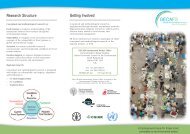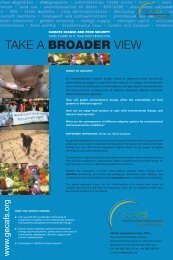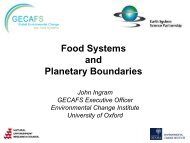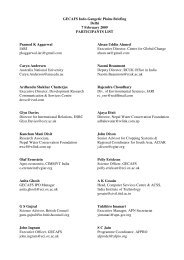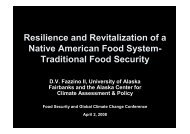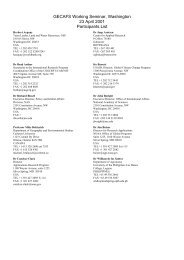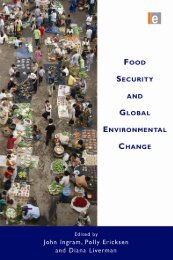From Food Production to Food Security - Global Environmental ...
From Food Production to Food Security - Global Environmental ...
From Food Production to Food Security - Global Environmental ...
- No tags were found...
You also want an ePaper? Increase the reach of your titles
YUMPU automatically turns print PDFs into web optimized ePapers that Google loves.
options. Examples already seen range from GIS technologies for fertilizer applications(Assimakopoulos et al., 2003) and laser technologies for field levelling (Jat et al., 2006) <strong>to</strong>radio-frequency identification (RFID) for traceability of produce though the food chain(Kelepouris et al., 2007) and low-cost detection of allergens in food stuffs (Bettazzi et al.,2008).ICT technologies (as with all technologies) are applied <strong>to</strong> the food system activities, affectingthe ways in which food producing, processing etc. are conducted. How will the application ofITC technologies affect the food security outcomes?An initial analysis <strong>to</strong> address this question was conducted at a COST (European Cooperationin Science and Technology) workshop held in Bruges, Belgium in June, 2009. The GECAFSfood system framework of four groups of food systems activities and nine elements of foodsecurity outcomes (Figure 1) was used <strong>to</strong> systematically identify examples of (i) how theapplication of example ICT technologies could be implemented in different food systemactivities, and (ii) how these could affect a range of food security outcomes. A number of theexamples are presented in a matrix of activities vs. outcomes (Table 1).By clearly identifying the full set of food system activities and example elements of the foodsecurity outcomes (Figure 1), the GECAFS food system approach provided the structure for amatrix (Table 1) <strong>to</strong> systematically identify possible impacts of example ITC technologies onfood security outcome. It details the way a given ICT technology can be applied <strong>to</strong> a givenfood system activity and how this in turn affects specific food security elements.Example 3: <strong>Food</strong> system concepts for framing scenarios analysesScenarios are “plausible and often simplified descriptions of how the future may develop,based on a coherent and internally consistent set of assumptions about key driving forces andrelationships” (MA, 2005b). Scenarios are neither forecasts of future events, nor predictionsof what might or will happen in the future. Rather, they develop and present carefullystructured s<strong>to</strong>ries about future states of the world that represent alternative plausibleconditions under different assumptions.Scenario exercises are increasingly being used <strong>to</strong> help decision makers and other stakeholdersaddress the ‘big picture’, complex challenges given future uncertainty. While the future offood production poses substantial questions (and hence is the focus of considerable researcheffort, as discussed above), the future of food security is even more complex. This is due <strong>to</strong>two main fac<strong>to</strong>rs. First, the individual nature of the food system drivers (demand, tradearrangements, climate, etc.; Figure 2) is uncertain, let alone the critically-importantinteractions among them. Second, food security is itself complex: it has nine major elements44



